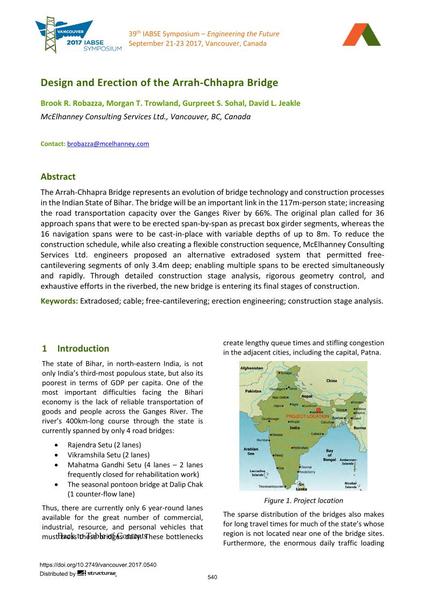Design and Erection of the Arrah-Chhapra Bridge

|
|
|||||||||||
Bibliographic Details
| Author(s): |
Brook R. Robazza
(McElhanney Consulting Services Ltd., Vancouver, BC, Canada)
Morgan T. Trowland (McElhanney Consulting Services Ltd., Vancouver, BC, Canada) Gurpreet S. Sohal (McElhanney Consulting Services Ltd., Vancouver, BC, Canada) David L. Jeakle (McElhanney Consulting Services Ltd., Vancouver, BC, Canada) |
||||
|---|---|---|---|---|---|
| Medium: | conference paper | ||||
| Language(s): | English | ||||
| Conference: | IABSE Symposium: Engineering the Future, Vancouver, Canada, 21-23 September 2017 | ||||
| Published in: | IABSE Symposium Vancouver 2017 | ||||
|
|||||
| Page(s): | 540-547 | ||||
| Total no. of pages: | 8 | ||||
| Year: | 2017 | ||||
| DOI: | 10.2749/vancouver.2017.0540 | ||||
| Abstract: |
The Arrah-Chhapra Bridge represents an evolution of bridge technology and construction processes in the Indian State of Bihar. The bridge will be an important link in the 117m-person state; increasing the road transportation capacity over the Ganges River by 66%. The original plan called for 36 approach spans that were to be erected span-by-span as precast box girder segments, whereas the 16 navigation spans were to be cast-in-place with variable depths of up to 8m. To reduce the construction schedule, while also creating a flexible construction sequence, McElhanney Consulting Services Ltd. engineers proposed an alternative extradosed system that permitted free- cantilevering segments of only 3.4m deep; enabling multiple spans to be erected simultaneously and rapidly. Through detailed construction stage analysis, rigorous geometry control, and exhaustive efforts in the riverbed, the new bridge is entering its final stages of construction. |
||||
| Keywords: |
cable extradosed erection engineering construction stage analysis free cantilevering
|
||||
